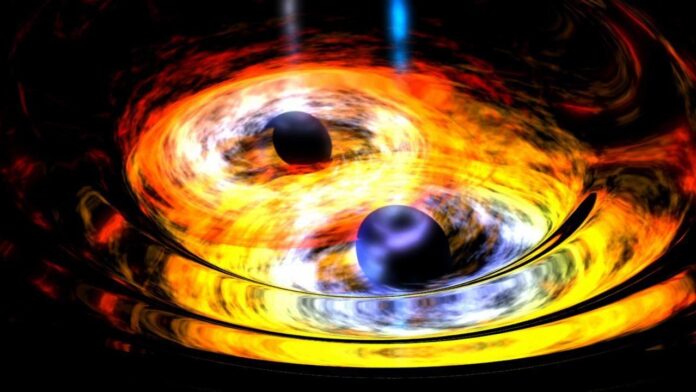Astronomers have long puzzled over an unusual gravitational wave event detected in 2023 — a collision between two black holes that defied conventional wisdom about how such massive and rapidly spinning objects form. The mystery has now been solved, thanks to sophisticated computer simulations that reveal the crucial role of magnetic fields in shaping these cosmic behemoths.
In November 2023, Earth-based detectors like LIGO, Virgo, and KAGRA captured ripples in spacetime called gravitational waves. This signal, designated GW231123, pointed towards a collision of two black holes located about 7 billion light-years away. But the characteristics of these black holes threw astronomers for a loop: each had masses around 100 and 140 times that of our sun and spun at near-light speeds.
The problem? Current theories suggest that stars massive enough to collapse into black holes with such extraordinary masses should explode as “pair-instability supernovae.” These cataclysmic events are so powerful they leave behind nothing, not even a black hole. As a result, scientists didn’t expect black holes to form within the mass range between roughly 70 and 140 times the sun’s mass.
While black holes can exist within this “mass gap” after mergers of existing smaller black holes, that wasn’t likely in this case. Mergers disrupt a black hole’s spin, but the colliding objects in GW231123 were spinning incredibly fast—at their theoretical maximum rotational speed. This meant something else entirely had to be at play.
A team led by astrophysicist Ore Gottlieb at the Flatiron Institute’s Center for Computational Astrophysics (CCA) took on the challenge, running complex computer simulations of stellar evolution and supernovae. Their key insight? The role of magnetic fields in a star’s final moments.
Magnetic Fields Rewrite the Script
Previous studies often overlooked magnetic fields in these extreme scenarios. Gottlieb and his team incorporated them into their models, revealing a fascinating twist: magnetic fields can significantly influence how leftover stellar material behaves after a supernova.
They simulated the death of a massive star with about 250 times the sun’s mass, watching it shed most of its mass before collapsing to form a black hole. Then, in a more intricate simulation, they factored in swirling magnetic fields present within the expanding cloud of debris surrounding the newly formed black hole.
“We found that these magnetic fields can push away some of this leftover material at almost the speed of light,” Gottlieb explained. The faster the star was rotating and the stronger the magnetic fields, the more efficiently matter could be expelled.
This expulsion process effectively reduces the mass transferred to the black hole. This means that even a massive progenitor star could leave behind a relatively smaller black hole within the forbidden mass gap. The simulations showed that under certain conditions, half of the initial stellar mass could be blown away!
A New Era in Black Hole Understanding
The discovery has far-reaching implications for how we understand black hole formation and evolution. It suggests:
- A Link Between Mass, Spin, and Magnetism: Stronger magnetic fields might lead to lighter and slower spinning black holes, while weaker fields could produce more massive and rapidly rotating ones. This connection opens up new avenues for investigation.
- Testing Through Gamma Ray Bursts: The simulations predict that the formation of these mass-gap black holes should be accompanied by a burst of gamma rays — high-energy light detectable on Earth. Detecting such a burst would provide powerful evidence to support this model.
The mystery of GW231123 has been solved, but it raises even more intriguing questions about the complex interplay between magnetic fields and gravity in the dramatic final moments of massive stars. It highlights how seemingly “impossible” events can unveil surprising truths about the universe’s most enigmatic objects.







































































